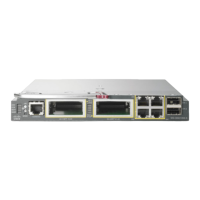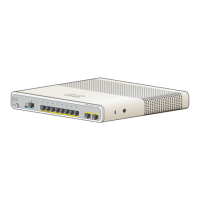• queue-limit—Specifies the maximum number of packets the queue can hold for a class policy configured
in a policy map.
• service-policy—Configures a QoS service policy.
• set—Specifies a value to be assigned to the classified traffic. For more information, see set, on page
662
• shape—Specifies average or peak rate traffic shaping. For more information about this command, see
Cisco IOS Quality of Service Solutions Command Reference available on Cisco.com.
To return to policy-map configuration mode, use the exit command. To return to privileged EXEC mode, use
the end command.
The class command performs the same function as the class-map global configuration command. Use the
class command when a new classification, which is not shared with any other ports, is needed. Use the
class-map command when the map is shared among many ports.
You can configure a default class by using the class class-default policy-map configuration command.
Unclassified traffic (traffic that does not meet the match criteria specified in the traffic classes) is treated as
default traffic.
You can verify your settings by entering the show policy-map privileged EXEC command.
Examples
This example shows how to create a policy map called policy1. When attached to the ingress direction, it
matches all the incoming traffic defined in class1, sets the IP Differentiated Services Code Point (DSCP) to
10, and polices the traffic at an average rate of 1 Mb/s and bursts at 20 KB. Traffic exceeding the profile is
marked down to a DSCP value gotten from the policed-DSCP map and then sent.
Device(config)# policy-map policy1
Device(config-pmap)# class class1
Device(config-pmap-c)# set dscp 10
Device(config-pmap-c)# police 1000000 20000 exceed-action policed-dscp-transmit
Device(config-pmap-c)# exit
This example shows how to configure a default traffic class to a policy map. It also shows how the default
traffic class is automatically placed at the end of policy-map pm3 even though class-default was configured
first:
Device# configure terminal
Device(config)# class-map cm-3
Device(config-cmap)# match ip dscp 30
Device(config-cmap)# exit
Device(config)# class-map cm-4
Device(config-cmap)# match ip dscp 40
Device(config-cmap)# exit
Device(config)# policy-map pm3
Device(config-pmap)# class class-default
Device(config-pmap-c)# set dscp 10
Device(config-pmap-c)# exit
Device(config-pmap)# class cm-3
Device(config-pmap-c)# set dscp 4
Device(config-pmap-c)# exit
Device(config-pmap)# class cm-4
Device(config-pmap-c)# set precedence 5
Device(config-pmap-c)# exit
Device(config-pmap)# exit
Device# show policy-map pm3
Command Reference, Cisco IOS XE Everest 16.5.1a (Catalyst 3650 Switches)
643
class

